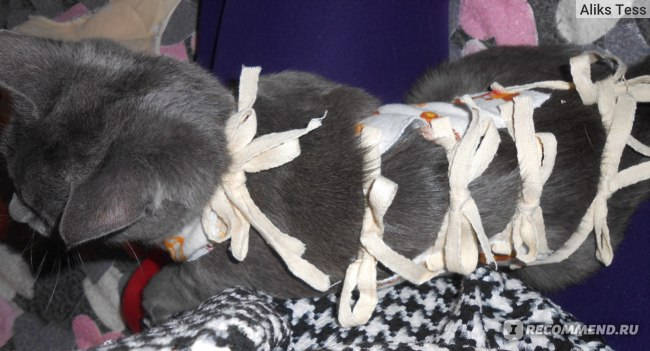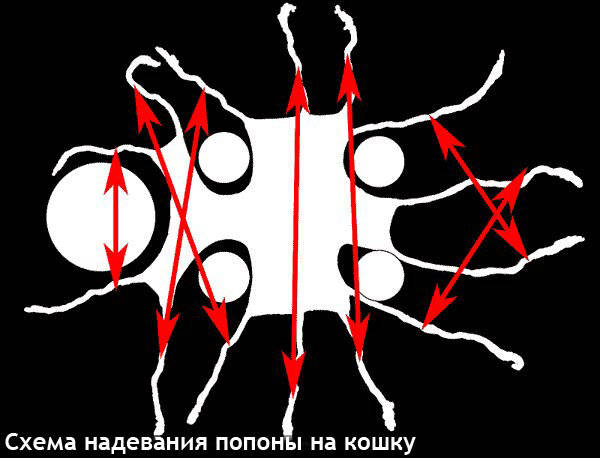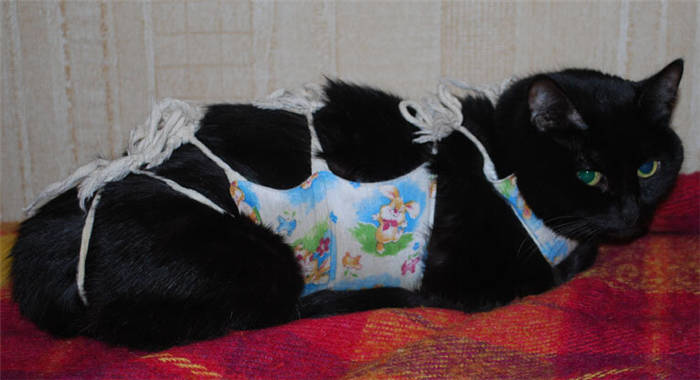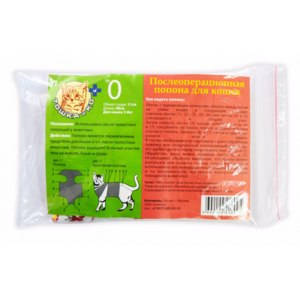Don't leave the long ends of the shoelaces. A cat can easily pull them with its teeth, loosen or untie the knot.

- How to put a post-operative cat blanket on a cat
- Is it necessary to wear a harness after spaying a cat when protection is still needed?
- How to make a postoperative cat's diaper with your own hands
- Preparing the material
- Measuring and cutting
- Sewing the popoose
- Cat nutrition regime after sterilization
- Rules for feeding a cat after spaying:
- What and when to feed
- Daily ration for an adult cat:
- Nuances of post-operative care
- Can a cat walk or jump after spaying?
- How many days later you can bathe
- What else you can and cannot do after surgery
- How to tie?
- How to choose
- Subtleties of use
- Toshka & Co. post-operative cloak for cats – review
How to put a post-operative cat blanket on a cat
I apologize in advance to those for whom this question is not relevant. If there is even one "fellow traveler", I'll be happy if this post will help.
My cat had surgery (mastectomy). Bought a blanket for her, gave it to the doctors before the surgery. There may have been some instructions on how to put it on the cat, but I have not seen it, because the operated cat was returned to me already in the poppin.
The first time I handled the stitches I had a problem – how to fix the hygiene product to the cat.
Googling, strangely enough, has not yielded results. Had to solve the puzzle myself. Several times I put the blanket on incorrectly (tied the wrong strings between them), a couple of times even "backwards", which very much upset the cat, which was not in the best of spirits.  Finally, however, by trial and error I figured it out. After that, there was no more problems.
Finally, however, by trial and error I figured it out. After that, there was no more problems.
I will post some illustrations here. I hope that after studying them no one will have any problems with putting on the harness.
The four little circles on the chart are the paws of the cat, and one big circle is the head. 
Arrows show what straps should be tied together on the cat's neck, withers, back, waist and rump.


Is it necessary to wear a harness after spaying a cat when protection is still needed?
The main purpose of the cover is to prevent pathogens from entering the injured tissues on the animal's body. In addition, it additionally protects against mechanical damage and ultraviolet light while walking the cat outside in the open sun.
One of the indications for wearing the blanket is to rehabilitate the animal after surgery and sterilization. At the final stage of surgery, stitches are placed, and some of the threads are on the outside. To prevent the cat from licking the wound and pulling out the suture material, a protective blanket is put on. With its help, tissue healing is faster and there is no risk of infection in the injured area.
Medical blankets are sold in specialized stores and veterinary pharmacies. They are made of non-woven hypoallergenic materials of natural origin. Provide sufficient air exchange. Great care should be taken when choosing such a product.
- high-quality tailoring;
- A natural, breathable material that absorbs moisture well;
- choosing the right size for your cat's weight and chest circumference (measure beforehand);
- Type of fastening – velcro and zippered models are practical.
Ponies come in a variety of colors. This is not a fundamental selection criterion, so the owner can decide for himself which color he likes best. However, experts advise to pay attention to light-colored models, on which it will be easier to notice the discharge from the wound.
Light colors will also help to control the cleanliness of the medical accessory, because it is very important to maintain the sterility of the dressing in contact with the operated area.
How to make a postoperative cat's diaper with your own hands
If there is no possibility to buy a ready-made medical bandage for a cat, you can make it with your own hands, using improvised materials.
Preparing the material
First of all, you will need a clean natural fabric. It must be soft and at the same time durable. Perfect calico and chintz. Preliminary material should be washed, since the fabric shrinks when washed.
Measuring and cutting
The next step is to take the measurements. It is better to do this together with a helper, because the cat will not sit quietly, and all manipulations of the owner will take for a game.
You should write down the data you have received, so that you can use it as a guide when sewing the blanket.
- We fold the fabric twice, with the wrong side on the outside;
- To ensure that the workpiece does not move, fasten it with pins;
- the top edge of the front part of the fold, mark this section with a pencil;
- according to the taken measurements, mark the notches for the paws on the fabric;
- measure the length of the fixing bandage at the spine, abdomen, at the tail between the hind legs, taking the measure as a reference, mark it, and then set aside a piece of fabric along the outside edge to form a corner;
- round it with a pencil;
- Marks are put on the fabric in the places where the fixing bandages will be located;
- Cut out the contours of the product, and then you should take out the pins.
Through these manipulations two blanks are created for sewing a medical cape.
Sewing the popoose
The cloth seams are overstitched at the edges to prevent the threads from falling out. Then all parts are placed on the wrong side and sewn by hand or with a sewing machine.
After sewing, you need to check the seams for strength. Be sure to treat the edges, so that the threads do not get into the wound and do not provoke the process of rotting.
At the final stage, a fitting of the poppet on the cat is carried out. Excess fabric can be removed.
Cat nutrition regime after sterilization
After spaying a cat, special attention should be paid to its diet and make significant adjustments to its daily menu. Since the metabolism in the animal's body slows down after this procedure and other important changes in the work of internal organs occur, proper nutrition will be an integral part of proper care for your pet.
Rules for feeding a cat after spaying:
1. In the first days after surgery the cat should not be given solid food. The stools must always be liquid, so that the post-operative stitches do not come apart when you go to the toilet.
2. 2. For the first two to four days the cat's ration should be reduced to a third of its usual amount.
3 On days 4-5 after surgery you can gradually increase portions by 100-150 grams per day.
4 Since cats after sterilization are prone to obesity, the usual daily food allowance should be reduced by 120-130 g.
What and when to feed
On the first day after sterilization you should not feed the cat until it has come out of anesthesia. If by the evening of the first day after waking up the animal shows a strong hunger, you can give her some lean broth from a syringe.
Food for a cat after sterilization should be easily digestible and of good quality. Fatty meats, raw and freshwater fish, fatty dairy products, smoked meats, pickles, legumes, raw eggs, as well as pearl barley, oatmeal and semolina are excluded from the diet.
To prevent urolithiasis and obesity, experts recommend feeding a cat 2-3 times a day in small portions.
Daily ration for an adult cat:
If symptoms of obesity appear after spaying, the cat is switched to a split diet.
If the owner feeds a domestic cat special food, it is recommended to choose high-quality compositions of premium or super-premium. Cheap foods contain many salts and heavy minerals that contribute to liver and kidney disease. There are special formulas for sterilized cats in the range of industrial foods. They can be used for everyday feeding of the pet, but you should not give such food to the cat in the first days after sterilization.
Nuances of post-operative care
The owner needs to ensure that the cat is properly cared for after spaying. And that care includes not only a healthy diet and treatment of the post-operative stitches, but also other important procedures to help the cat recover quickly.
Can a cat walk or jump after spaying?
The first day after surgery is the hardest. The owner needs to be with her all the time. Anesthesia impairs the cat's coordination of movements and consciousness, so it is important to watch the cat's gait and not to let it fall, especially from a height. It is recommended to prepare a sleeping place for the cat on the floor by laying a clean towel or blanket. In no case should the cat be placed in places where there are drafts, as well as allow sudden movements of the animal.
For the first five days after surgery, cats should not jump or play active games. Jumping on high surfaces should be avoided for 10-14 days after sterilization. The owner needs to monitor the cat's behavior regularly until it has fully recovered.
Already on the 6th-7th day the cat can go for a walk outside, but only under supervision. A walk in the fresh air will benefit the body.
How many days later you can bathe
After a surgical procedure, a cat should not be bathed until the wound has fully healed. The first bath should not be performed earlier than 14 days after sterilization. To wash a sterilized cat it is recommended to use special dry shampoos.
If there is dried blood or blood-liquor left on the cat's body after sterilization, the owner can gently remove the contamination with Chlorhexidine or hydrogen peroxide. Potato starch can be used to clean the coat, rubbed gently into the animal's coat.
What else you can and cannot do after surgery
Many owners do not know how to properly care for a cat after spaying, and often make serious mistakes that can cause some damage to the health of the animal. Let's look at what you can and can't do after spaying.
How to tie?
Beforehand, make sure that you have properly positioned the blanket. Symmetrical notches for the front paws serve as a guide. The animal's head should be slightly in front of them, and the notches themselves will be in the area of the animal's front armpits.
A simple, classic popoose has 14 laces to hold it in place, symmetrically placed along its side edges. They will need to be tied on the cat's back. Considering that you will have to take the bandage off periodically, you should not make the knots too tight. But it is also dangerous to tie the laces too loosely: the animal may untie them with his teeth and later get rid of the bandage.
- Tie the harness on the cat from the head. Take the first two laces from the front and connect them to the animal's neck.
- The next two pairs of laces should be tied crosswise in the area of the cat's shoulder blades, i.e. the left tie from the second pair is connected to the right tie from the third pair, the right tie from the second pair is connected to the tie from the third pair of ties, which is on the right side. In this way you should have a lace cross over the withers.
- The next ties are tied in pairs on the back.
- The last two pairs of ties are fixed crosswise on the back of the cat's torso.
It is important to make sure that the postoperative bandage does not cover the animal's excretory orifices: the anus and the urinary tract. Otherwise, because of the discomfort the pet will actively try to take off the blanket. And you will have to face the fact that the bandage will soon get dirty.
The bandage should not squeeze the cat's body tightly. If you notice your pet moving stiffly, loosen the lacing.
Your pet may tear his or her postoperative bandage with his or her teeth or get very dirty, then you will need to replace it.
If the surgical stitch is small, you don't have to remove the entire bandage to treat it – Only release the part of your torso where the wound is located. This will save you time and effort in tying and securing the bandage.
How to choose
It is necessary to choose the harness for the cat, for example, after neuter or spaying very carefully. You should be guided by the following important criteria.
- Material. Choose post-operative poppies, which are made of environmentally friendly and safe materials. This thing should always be breathable. It is desirable to buy poppins, which easily absorb liquid, so that the wound of the pet always stays dry and not wet.
- Clips. Check the quality of the fastening parts. The poppies are most often made with zippers or Velcro or simple ties.
- Size. You should choose popos, the size of which corresponds to the size of the pet itself. It is desirable to make all the necessary measurements in advance. You should know the volume of the cat's chest, as well as the distance from the base of the shoulders to the tail. Usually, all the size parameters of the poppies are indicated on the package.
- Color. In this case, you should pay attention to the color not at all because of its beauty, but for practicality. For example, on light-colored materials, it will be easier to notice any secretions coming from the wound. In addition, you will easily see that the product is dirty, and it should be sent to the wash.
- Quality of workmanship. The blanket should be made properly. It should not slip or move off the animal's body. If this thing is not made as it should be, it will be of no use, and it will be difficult to put it on. There should not be any threads sticking out or crumbling on the material.
- Packaging. It is very important to pay due attention to the branded packaging in which the capon is sold. It is a thing that will be in contact with the animal's body and the postoperative suture, so it should be very well sealed.
It is advisable to choose options that are sold in fully transparent sealed packages. In this case, it will be much easier to assess all the necessary parameters inherent in the thing.
Subtleties of use
Popona is put on cats immediately after some kind of abdominal surgery. Ideally, a veterinarian will put this item on the pet for the first time and then show you how to properly tie and remove it on the body. The utmost care should be taken when putting the popoose on your pet's body, as post-operative wounds often cause severe pain. The animal will suffer from sudden and uncomfortable movements of the owner. The blanket should be put on the pet as follows.
- The woven part should be attached to the pet's tummy and placed under the front legs. The ribbons should be carefully pulled up to the back of the cat.
- Now you need to tie the ribbons one by one. The first and second pairs should be fixed on cat's neck up to the area where the front paws are.
- The third pair of ties needs to be carefully fixed behind the paws of the animal and then connected to the ends of the second pair.
- The fourth and fifth pairs of ribbons are placed on the back of the cat. The latter should be as close to the hind legs as possible.
- As a result, you will have a pair of ribbons on each side – they should be neatly tied together in pairs. In doing so, you will need to wrap a ring around animal's thigh. The ends of both pairs on both sides need to be tied together on the back before the tail.
After attaching the blanket, make sure that it sits well and does not slip. But this does not mean that it should be tightened with the last of its strength on the body of the operated pet. Secure the cape to the best of your ability, but don't overtighten it, or the cat will be in pain and uncomfortable. Adjust the degree of tension of the ties if necessary.
For the cat's safety the veterinarians recommend to tie the ends of the ribbons in such a way, that it leaves a little free edge. Otherwise, there is a danger of strangling the pet with longer ribbons. Also, you should not leave the animal in the blanket alone, since very often cats try to pull the cloak off themselves to lick the wound.
Toshka & Co. post-operative cloak for cats – review
It's been a year, and now I'm ripe for this review. I strongly hope that the comments will not contain opponents of sterilization of animals who believe that a cat should not be deprived of the joy of motherhood, pyometra was invented by veterinarians, and in general: "For centuries, cats lived unsterilized, and everything was fine. Let her walk like that, and if she screams, I'll buy drops or find a cat." Nowadays, they are screaming from every newscaster about why animals should be spayed, and if you still don't understand that, it's sad, I don't even want to waste time and nerve. Let all the consequences be on your conscience.
On the other hand, what are such people to do in a review on the popovers?)
By the way, if you want to get to the point quickly, scroll on, otherwise I'm going to babble)
As a matter of fact, I currently have two cats who can be classified as "consequences". Beautiful consequences, but things might not have turned out so well for them. One I found as a kitten in a dysfunctional area of town. Actually, I washed, treated, spayed, and have been living side by side for almost 10 years now.
I wasn't planning on getting a second cat. You can't save them all, and you can't shelter them all, I understand that.
Last year my husband and I went to the sea. I love vacationing in seaside villages, and this year was no exception. We lived in my favorite village. Animal lovers in such places need to be superficial and a little blunt, to be frank. All these settlements are akin to our villages – the vet care is bad there, and people treat cats and dogs, for the most part, like furniture or fruit. Eating is good, nice. If it dies or gets sick, the hell with it. You don't hear about spaying. I do not want to generalize, my mother also lives in a remote village without a veterinary clinic, but she went to town and spayed her cats, now takes them for vaccinations, worming regularly. And I know that she is the only one in this village, and the others think she is strange and "urban".







